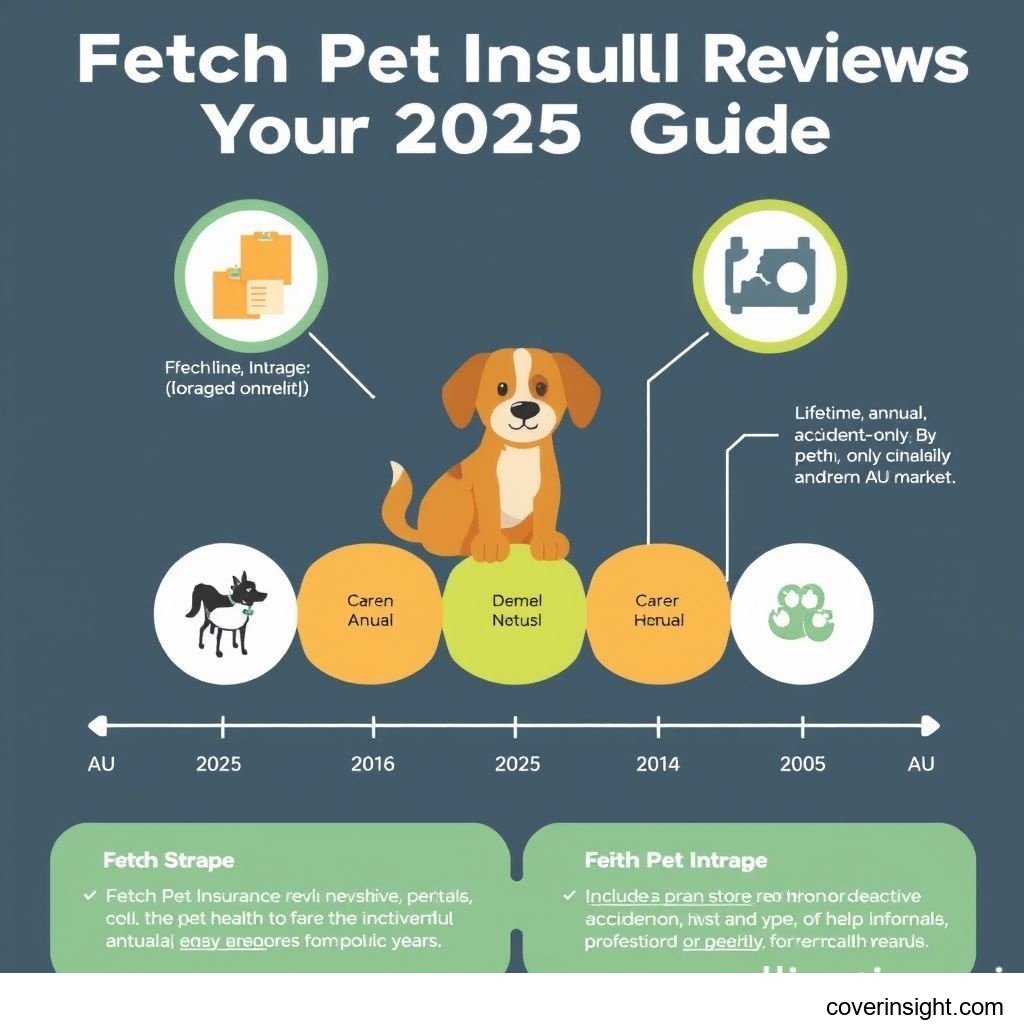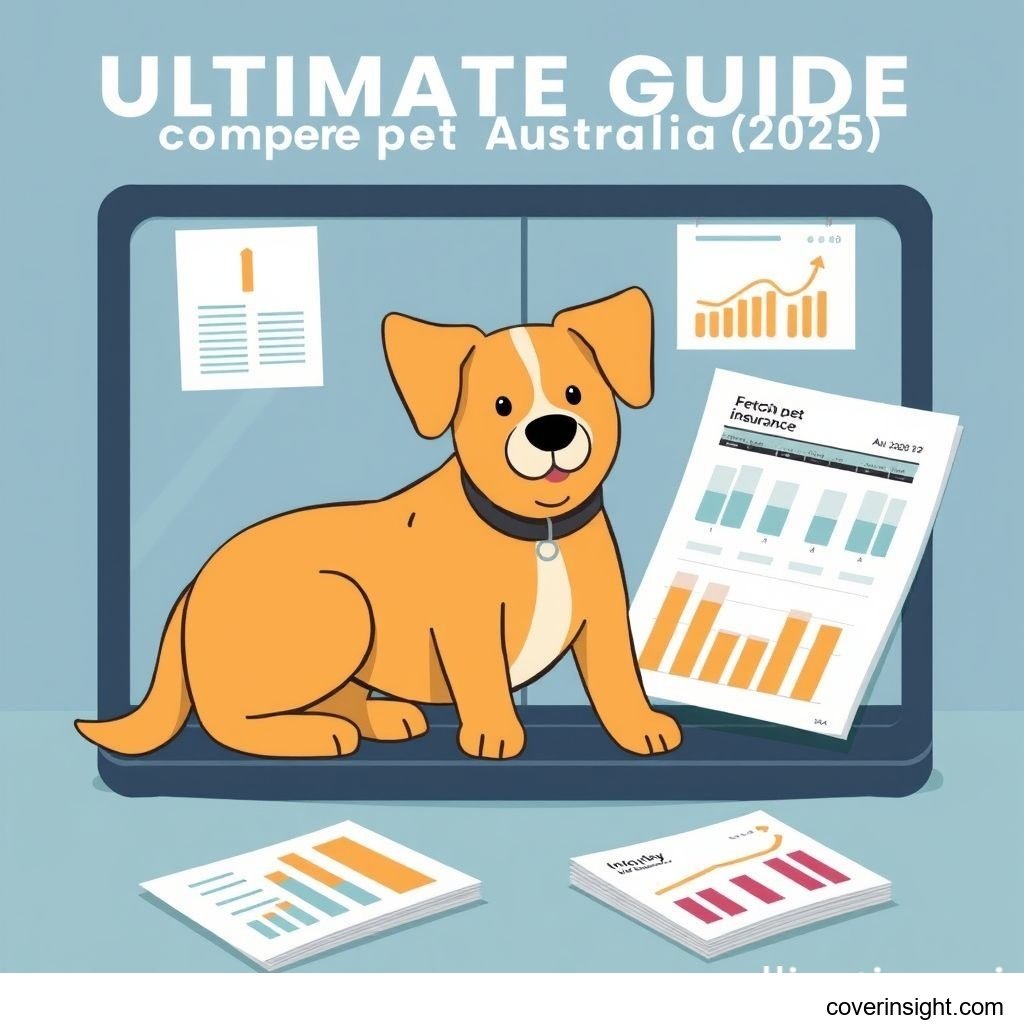Introduction
As pet ownership continues to rise across Australia, so does the awareness of the financial commitments involved in ensuring our furry, feathered, or scaled companions receive the best possible care. Veterinary costs can quickly escalate, especially in emergencies or for ongoing health issues. This makes pet insurance an increasingly vital consideration for many Australian households. In 2025, navigating the myriad of options available requires a smart approach. This guide provides comprehensive fetch pet insurance reviews alongside a broader comparison to help you make an informed decision for your beloved pet's future. Understanding your options is key to protecting both your pet and your wallet.
Coverage Details
Understanding what your pet insurance policy covers, and perhaps more importantly, what it doesn't, is crucial. Policies vary significantly between providers, and a detailed look into the terms and conditions is always recommended. This section breaks down typical inclusions, common exclusions, and specific considerations like chronic condition coverage and dental care coverage.
What’s Included
Most comprehensive pet insurance policies in Australia are designed to cover a significant portion of unexpected veterinary expenses. Common inclusions are:
-
Accident Coverage: This typically covers costs associated with injuries from accidents, such as broken bones, poisoning, snake bites, or car accidents. This often includes emergency vet visits, hospitalization, surgery, and medication related to the accident.
-
Illness Coverage: Beyond accidents, this covers a wide range of illnesses, from minor infections to more serious conditions like cancer or diabetes. Treatments like consultations, diagnostics (X-rays, ultrasounds, blood tests), hospitalization, and specialist referrals are usually included.
-
Emergency Care: This ensures your pet can receive immediate attention during critical situations.
-
Prescription Medications: Costs for medications prescribed by a veterinarian for covered conditions are typically reimbursed.
-
Surgery and Hospitalisation: Major medical procedures and extended stays at the veterinary clinic are often a core part of comprehensive plans.
-
Cruciate Ligament Conditions: Many policies specifically list coverage for cruciate ligament issues, which are common and costly.
Common Exclusions
While policies aim to be comprehensive, certain exclusions are common across the industry. Being aware of these can prevent future surprises.
-
Pre-existing Conditions: This is one of the most common exclusions. Any illness or injury that your pet showed signs of before the policy started or during the waiting period will generally not be covered. Some policies differentiate between 'curable' and 'incurable' pre-existing conditions, offering limited future coverage for the former.
-
Routine and Preventative Care: Things like vaccinations, flea and worming treatments, routine check-ups, and elective procedures (e.g., desexing) are usually not covered under standard accident and illness policies. Some providers offer optional wellness add-ons for these.
-
Cosmetic Procedures: Any surgery or treatment performed solely for cosmetic reasons.
-
Pregnancy and Breeding: Costs related to breeding, pregnancy, birth, or raising offspring are typically excluded.
-
Behavioral Conditions: While some policies may offer limited coverage for consultations related to behavioral issues, long-term treatment or specialized training for behavioral problems are often excluded.
-
Specific Conditions: In rare cases, certain breeds may have exclusions for conditions predisposed to them, or very specific conditions might be listed as not covered.
Chronic Condition Coverage Explained
For pet owners, understanding chronic condition coverage is paramount. Chronic conditions, such as diabetes, arthritis, allergies, or kidney disease, require ongoing management and can be very expensive over a pet's lifetime. Many policies offer coverage for chronic conditions, but it's vital to check the specifics:
-
Lifetime vs. Annual Limits: Some policies may have a lifetime limit for a specific chronic condition, while others may reset the annual limit each year, allowing for continued coverage.
-
Waiting Periods: Ensure you understand any waiting periods before a chronic condition can be claimed.
-
Pre-existing Status: If the chronic condition showed any signs before the policy's inception or during the waiting period, it will almost certainly be considered a pre-existing condition and excluded. This is a critical point to clarify when looking at fetch pet insurance reviews or any other provider.
-
Level of Support: Some policies may cover medications, special diets, or ongoing therapies required for chronic conditions, while others might be more restrictive.
Thoroughly reviewing the Product Disclosure Statement (PDS) is essential to ascertain the extent of chronic condition coverage.
Essential Dental Care Coverage Options
Dental care coverage is another area where policies can differ significantly. Dental health is a major component of a pet's overall well-being, and dental diseases are very common.
-
Accident-Related Dental: Most standard accident and illness policies will cover dental injuries resulting from an accident, such as a fractured tooth.
-
Illness-Related Dental: Coverage for illnesses like gingivitis, periodontal disease, or abscesses is less common in standard policies but often available through add-ons or more premium plans. This typically includes dental examinations, scaling, polishing, extractions, and treatments for dental diseases.
-
Preventative Dental: Routine dental check-ups, cleanings, and preventative care are generally not covered unless you opt for a specific wellness package.
-
Annual Limits: Even when covered, dental treatments often have separate annual limits lower than the overall policy limit.
When evaluating fetch pet insurance reviews or any provider, inquire specifically about the scope of dental care coverage to ensure it aligns with your pet's needs.
Cost Analysis
The cost of pet insurance is a major factor for most pet owners. Premiums can vary widely based on several elements. Understanding these factors and knowing how to potentially reduce costs can help you find an affordable policy without compromising on essential coverage.
Price Factors
Several elements influence the premium you pay for pet insurance:
-
Pet's Breed: Certain breeds are predisposed to specific health conditions (e.g., hip dysplasia in large breeds, breathing issues in brachycephalic breeds), leading to higher premiums.
-
Pet's Age: Premiums generally increase with your pet's age. Older pets are more prone to illnesses and chronic conditions. It's often cheaper to insure a pet when they are young.
-
Pet's Species: Cats are typically cheaper to insure than dogs.
-
Chosen Policy Type: Comprehensive accident and illness policies are more expensive than accident-only policies or basic illness plans.
-
Deductible/Excess: A higher excess (the amount you pay upfront per claim) usually results in lower monthly or annual premiums.
-
Reimbursement Rate: The percentage of the vet bill that the insurer pays back (e.g., 70%, 80%, 90%) directly impacts the premium. A lower reimbursement rate means lower premiums.
-
Location: Veterinary costs can vary by region, which may influence premiums.
-
Optional Add-ons: Including extras like routine care, behavioral therapy, or specific disease coverage will increase the premium.
Saving Tips
Reducing your pet insurance costs doesn't necessarily mean sacrificing quality coverage. Here are some effective saving tips:
-
Start Early: Insuring your pet when they are young and healthy will secure lower premiums and avoid pre-existing condition exclusions for future ailments.
-
Choose a Higher Excess: If you can afford to pay a larger amount out-of-pocket when a claim arises, opting for a higher excess will lower your regular premiums.
-
Adjust Reimbursement Rate: Consider a slightly lower reimbursement rate (e.g., 80% instead of 90%) if it significantly reduces your premium and you can cover the difference.
-
Compare Quotes: Don't just settle for the first quote. Use online comparison tools and directly contact multiple providers to find the best value. This is where fetch pet insurance reviews can be particularly helpful for understanding market positioning.
-
Bundle Policies: Some insurers offer discounts if you insure multiple pets or combine pet insurance with other insurance products (e.g., home and contents).
-
Pay Annually: Many insurers offer a discount for paying your premium annually instead of monthly instalments.
-
Maintain Pet Health: While not directly a saving on premiums, preventative care can reduce the need for claims, saving on deductibles and potentially preserving your no-claims bonus if applicable.
-
Review Your Policy Annually: As your pet ages, their needs and your financial situation might change. Reviewing your policy each year ensures it still meets your requirements and budget.
Why Fetch Pet Insurance Reviews Matter in 2025
When looking for pet insurance in Australia, many pet owners turn to fetch pet insurance reviews as a benchmark. Fetch Pet Insurance, underwritten by The Hollard Insurance Company, has established itself as a prominent player in the market. Its online presence and user-friendly interface make it a popular choice for those seeking direct and efficient insurance solutions. The insights derived from fetch pet insurance reviews offer a realistic perspective on what to expect regarding customer service, claims processing, and policy features.
Customer Experience Insights
Analyzing fetch pet insurance reviews reveals consistent themes regarding customer experience. Many users highlight the ease of the online quoting and application process. The digital platform is often praised for its intuitive design, making policy management straightforward. Claims submission, typically done online, is another area frequently mentioned, with feedback often focusing on the speed and efficiency of processing. Positive reviews often cite helpful and responsive customer service, which is crucial during stressful times when a pet is unwell. Conversely, some reviews might touch on the specifics of claim approvals or the interpretation of policy terms, which are common points of contention across all insurers. Understanding these nuances from various fetch pet insurance reviews helps set realistic expectations.
Policy Flexibility
A key aspect highlighted in fetch pet insurance reviews is the perceived flexibility of their policy offerings. Fetch typically provides different levels of coverage, ranging from accident-only to comprehensive accident and illness plans, often with optional add-ons. This allows pet owners to tailor a policy to their specific budget and their pet's needs. The ability to adjust excesses and reimbursement rates is another feature that contributes to this flexibility. This customisation is particularly appealing to those who want to balance premium costs with the level of financial protection they receive. Before committing, compare how this flexibility stacks up against other providers' options, ensuring the chosen plan adequately covers potential veterinary expenses your pet might incur.
Making the Right Choice for Your Pet
Choosing the right pet insurance policy requires careful consideration, extending beyond just reading fetch pet insurance reviews. It involves assessing your pet's specific needs, your financial comfort, and the overall market offerings.
Comparing Providers Beyond Fetch Pet Insurance Reviews
While fetch pet insurance reviews offer valuable insights, it's crucial to broaden your comparison. Australia boasts a competitive pet insurance market with numerous reputable providers. When comparing, consider the following:
-
Policy Types: Look at accident-only, accident and illness, and comprehensive plans from various insurers.
-
Reimbursement Rates and Limits: Compare the percentage of vet bills reimbursed and the annual or lifetime limits on claims.
-
Excess Options: See what deductible options are available and how they impact the premium.
-
Waiting Periods: Understand the waiting periods for accidents, illnesses, and specific conditions like cruciate ligament injuries.
-
Exclusions: Pay close attention to pre-existing conditions, bilateral conditions, and specific breed exclusions.
-
Reputation and Customer Service: Research independent reviews, financial stability (check with the Australian Prudential Regulation Authority), and claims handling efficiency.
-
Additional Benefits: Some policies offer benefits like emergency boarding, overseas travel coverage (if applicable), or complementary therapies.
Utilise resources like Insurance Resources Global, to get a broader perspective on the market.
Understanding Policy Limits and Deductibles
Delving into the specifics of policy limits and deductibles is paramount. These two components directly influence your out-of-pocket expenses.
-
Annual Limit: This is the maximum amount the insurer will pay out in a 12-month policy period. Some higher-tier plans or policies with lifetime conditions might have higher or no annual limits for specific issues.
-
Sub-limits: Some conditions (e.g., behavioral therapy, prescription diets, specific dental procedures, or chronic condition coverage) may have their own separate, lower annual limits within the overall policy limit.
-
Deductible (or Excess): This is the fixed amount you pay per claim or per year before the insurer starts paying. A higher deductible typically means lower premiums but a larger out-of-pocket expense when you claim. It’s important to find a balance that suits your budget.
For instance, if your policy has a $200 excess and an 80% reimbursement rate, on a $1,000 vet bill, you would first pay the $200 excess, leaving $800. The insurer would then reimburse 80% of that $800, which is $640. Your total out-of-pocket would be $200 (excess) + $160 (20% of remaining bill) = $360.
This granular understanding is vital for managing your finances effectively.
FAQs
Here are some frequently asked questions regarding pet insurance in Australia for 2025:
How much does fetch pet insurance reviews cost?
The cost of fetch pet insurance reviews varies widely. Premiums are influenced by your pet's breed, age, species, and your chosen level of coverage. Factors like the selected deductible (excess) and reimbursement rate also play a significant role. For a young, healthy cat, premiums might start from around $30-$40 per month for comprehensive cover, whereas a large, older dog with a history of specific breeds might be upwards of $100-$150 per month. It's always best to get a personalised quote directly from Fetch Pet Insurance to get an accurate estimate.
What affects premiums?
Premiums are primarily affected by the risk profile of your pet and the extent of coverage you select. Key factors include your pet's age (older pets cost more), breed (some breeds are prone to specific health issues), species (dogs generally cost more than cats), and your location (vet costs vary). The level of coverage (e.g., accident-only vs. comprehensive), your chosen excess, and the reimbursement rate also directly influence the premium amount. Insurers also consider the general trends in veterinary medicine costs, which can increase over time.
Is it mandatory?
No, pet insurance is not mandatory in Australia. Unlike compulsory third-party (CTP) insurance for vehicles, there is no legal requirement to have pet insurance. However, due to the high and unpredictable costs of veterinary care, many pet owners choose to invest in it for financial protection and peace of mind. It allows them to make decisions based on the best medical options for their pet, rather than solely on their ability to pay. You can learn more about general insurance guidelines from the Insurance Council of Australia.
How to choose?
Choosing the right pet insurance involves comparing various policies and considering your pet's individual needs. Start by assessing your budget and what level of risk you are willing to take. Research different providers, looking at their reputation, customer service, and claims process. Pay close attention to the Product Disclosure Statement (PDS) for details on exclusions, waiting periods, annual limits, chronic condition coverage, and dental care coverage. Utilise online comparison tools and read independent fetch pet insurance reviews to understand real-world experiences. Prioritise comprehensive coverage if your budget allows, especially for younger pets. Consider your financial resilience: can you cover an unexpected $5,000 vet bill without insurance? If not, coverage is likely a good idea. For more tailored guidance within Australia, explore resources like AU Insurance Home.
Consequences of no coverage?
The primary consequence of not having pet insurance is the direct financial burden of unexpected veterinary expenses. Without coverage, you would be solely responsible for 100% of the costs for accidents, illnesses, or chronic conditions. This could lead to significant out-of-pocket expenses, potentially thousands of dollars for major surgeries or ongoing treatments. In worst-case scenarios, pet owners might face difficult decisions about their pet's care based on affordability, rather than what's medically best. It can also cause financial stress, impacting household budgets, especially during emergencies.
Conclusion
Choosing the right pet insurance in Australia for 2025 is a decision that requires thorough research and a clear understanding of your pet's needs and your financial capacity. While fetch pet insurance reviews offer valuable insights into one prominent provider, a comprehensive comparison across the market is always recommended. Focus on policies that align with your pet's specific requirements, especially regarding chronic condition coverage and dental care coverage. By carefully evaluating coverage details, understanding cost factors, and leveraging available resources, you can secure a policy that provides peace of mind and ensures your beloved companion receives the best possible care for years to come. Protecting your pet's health is an investment worth making.








Comments